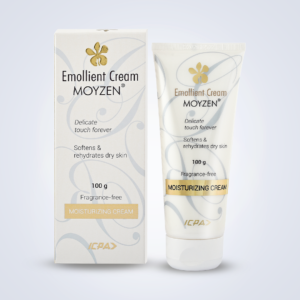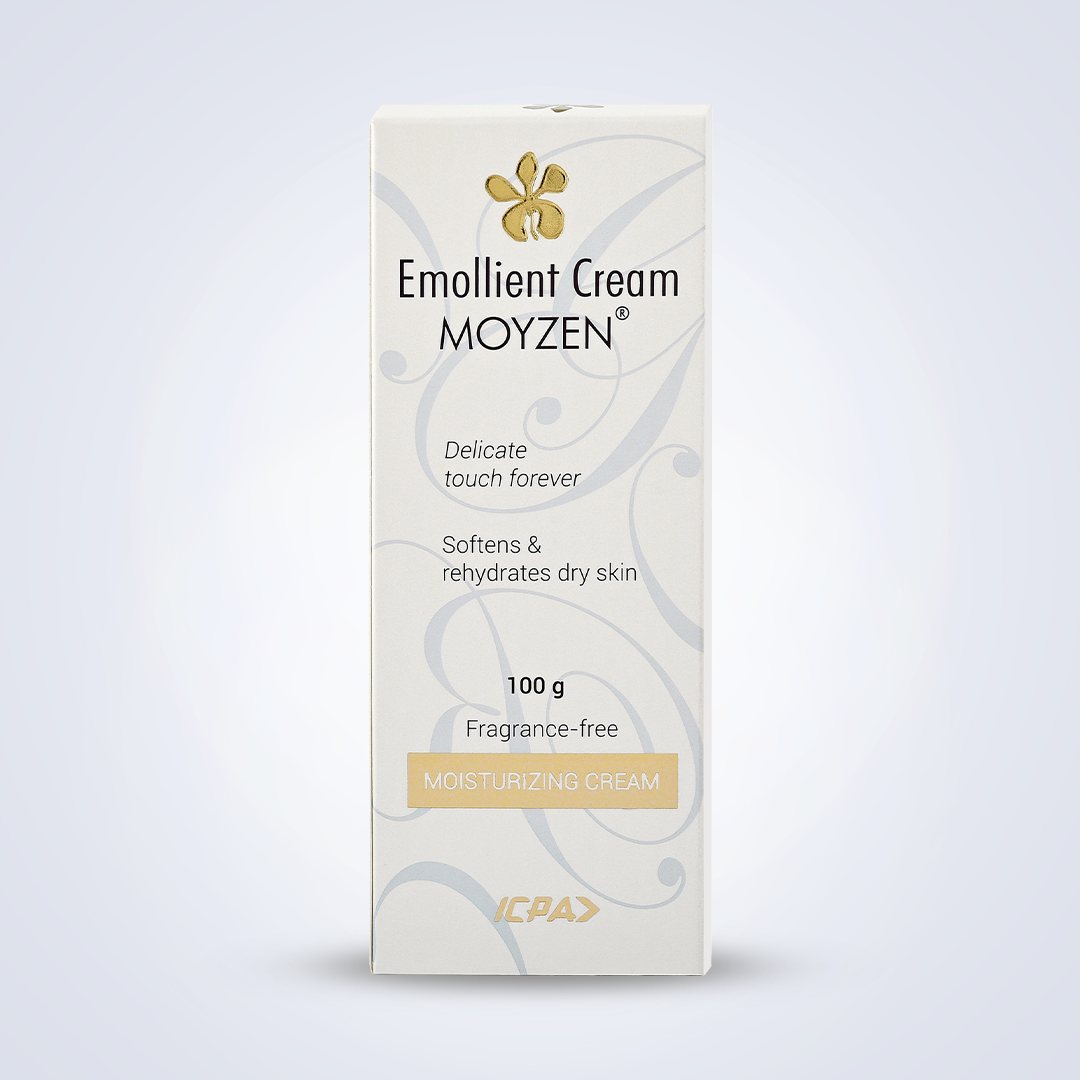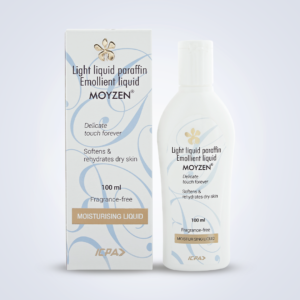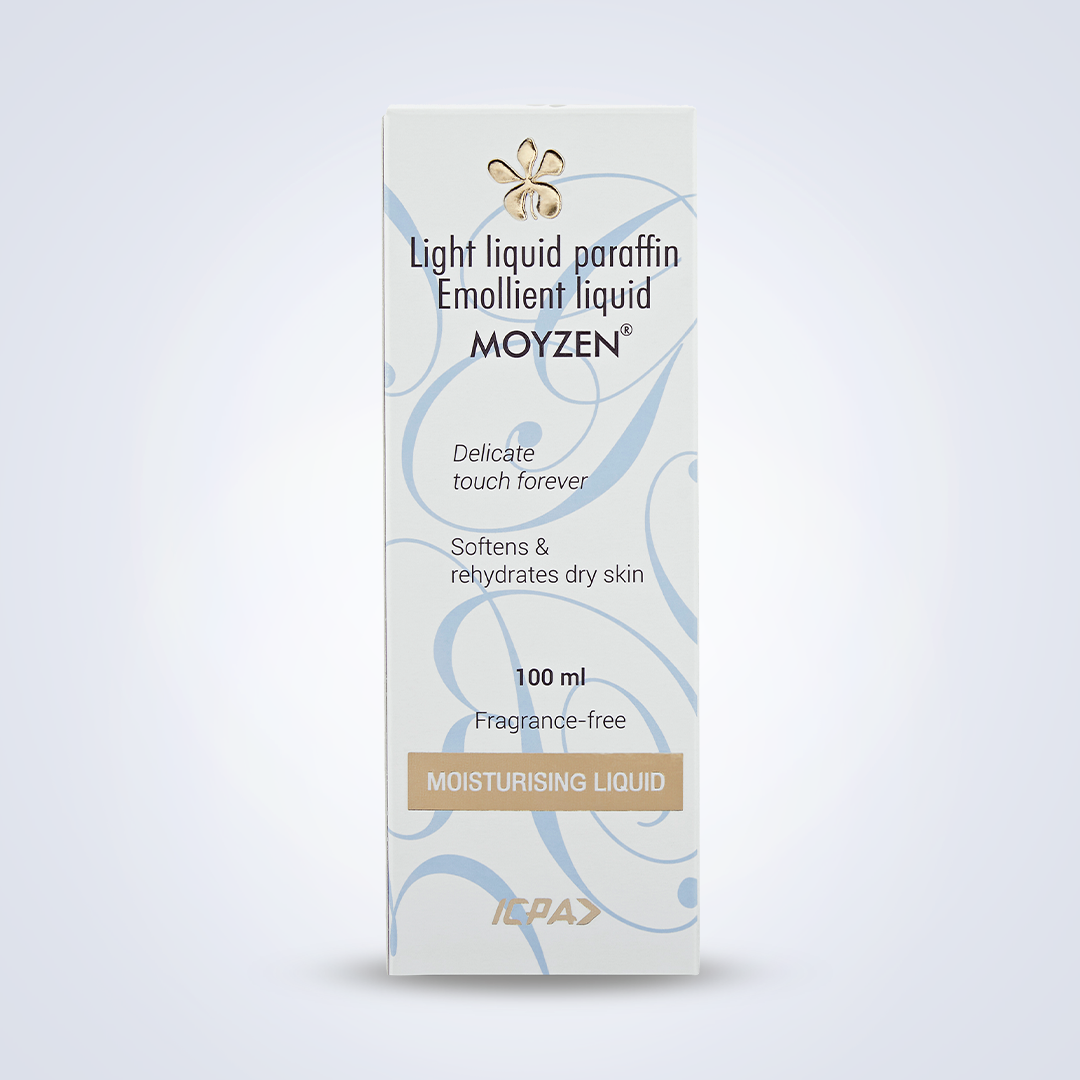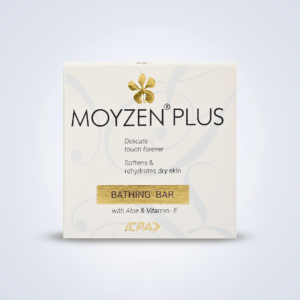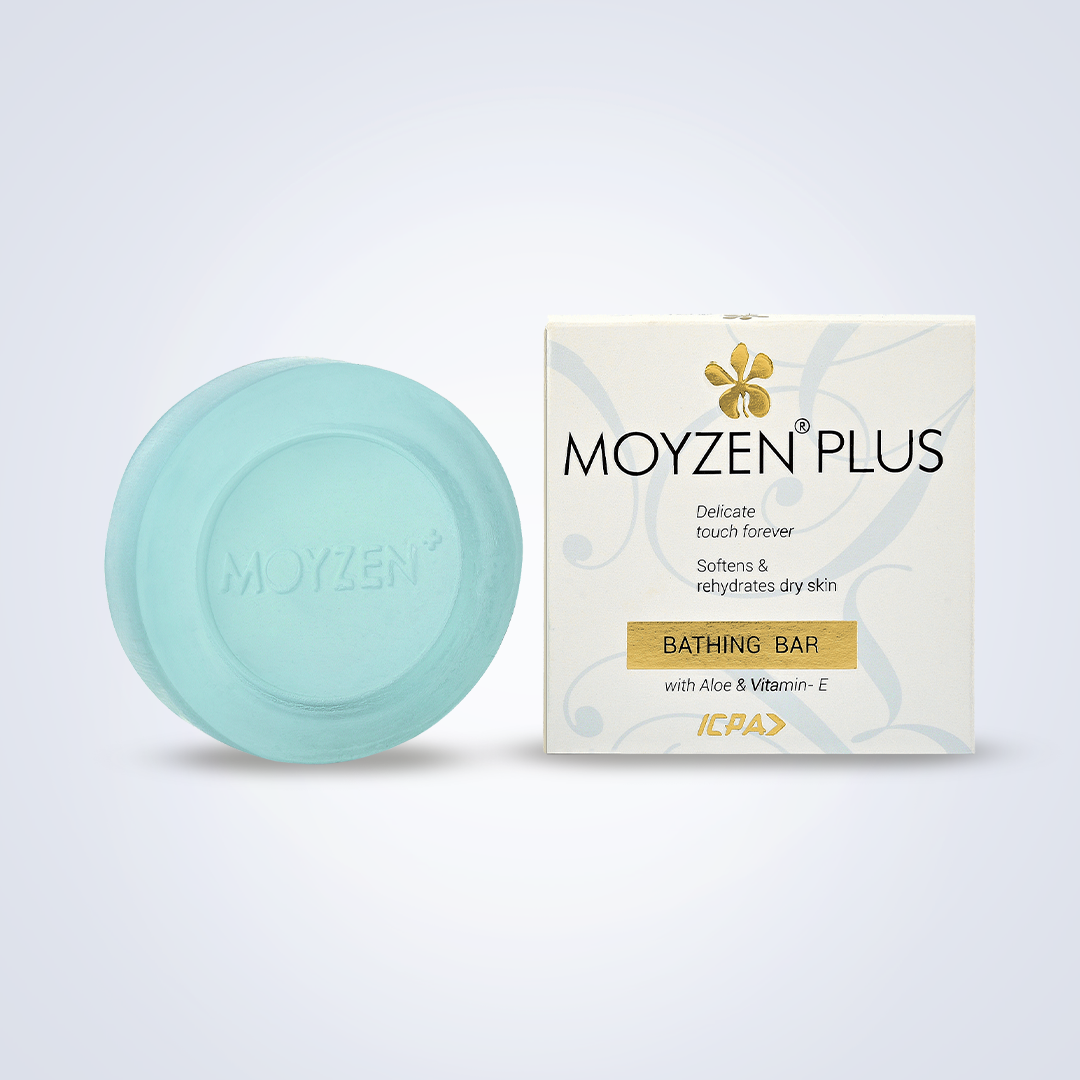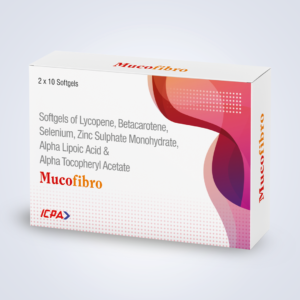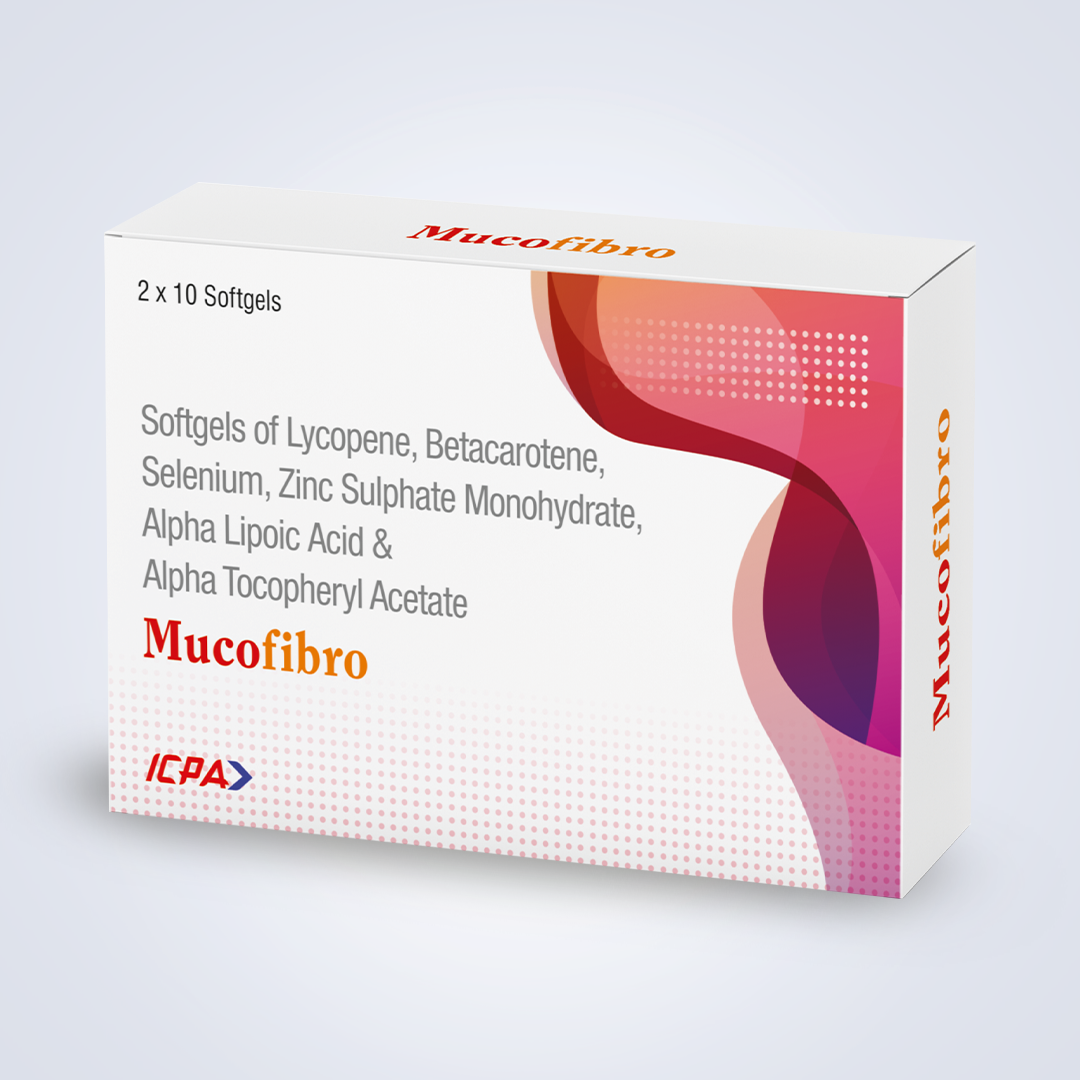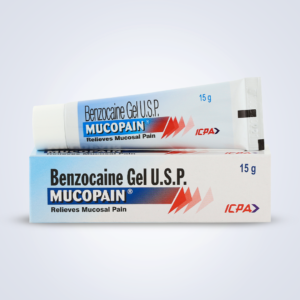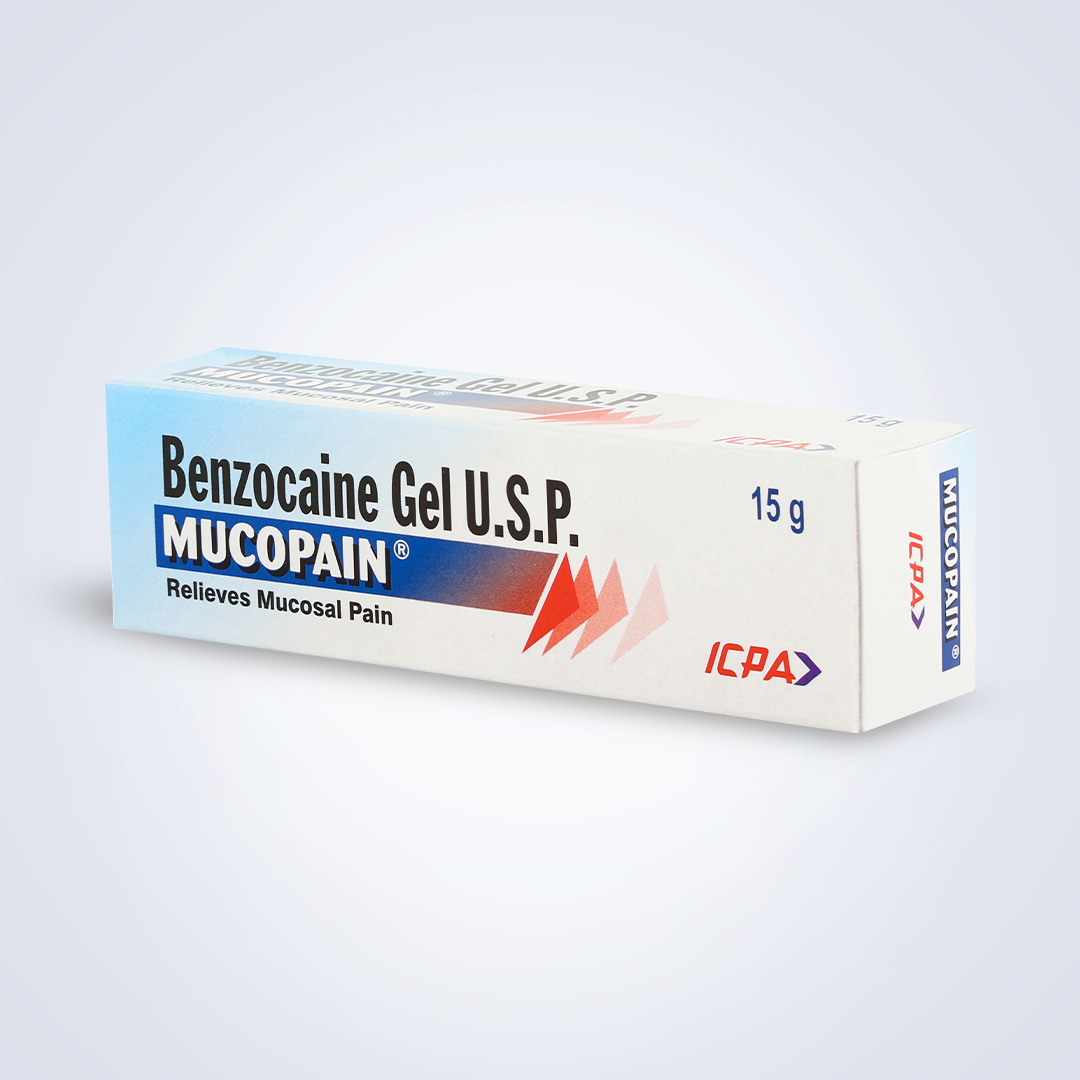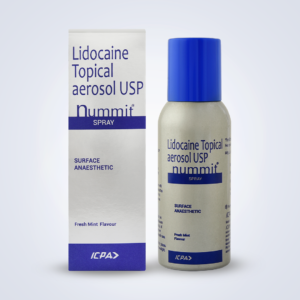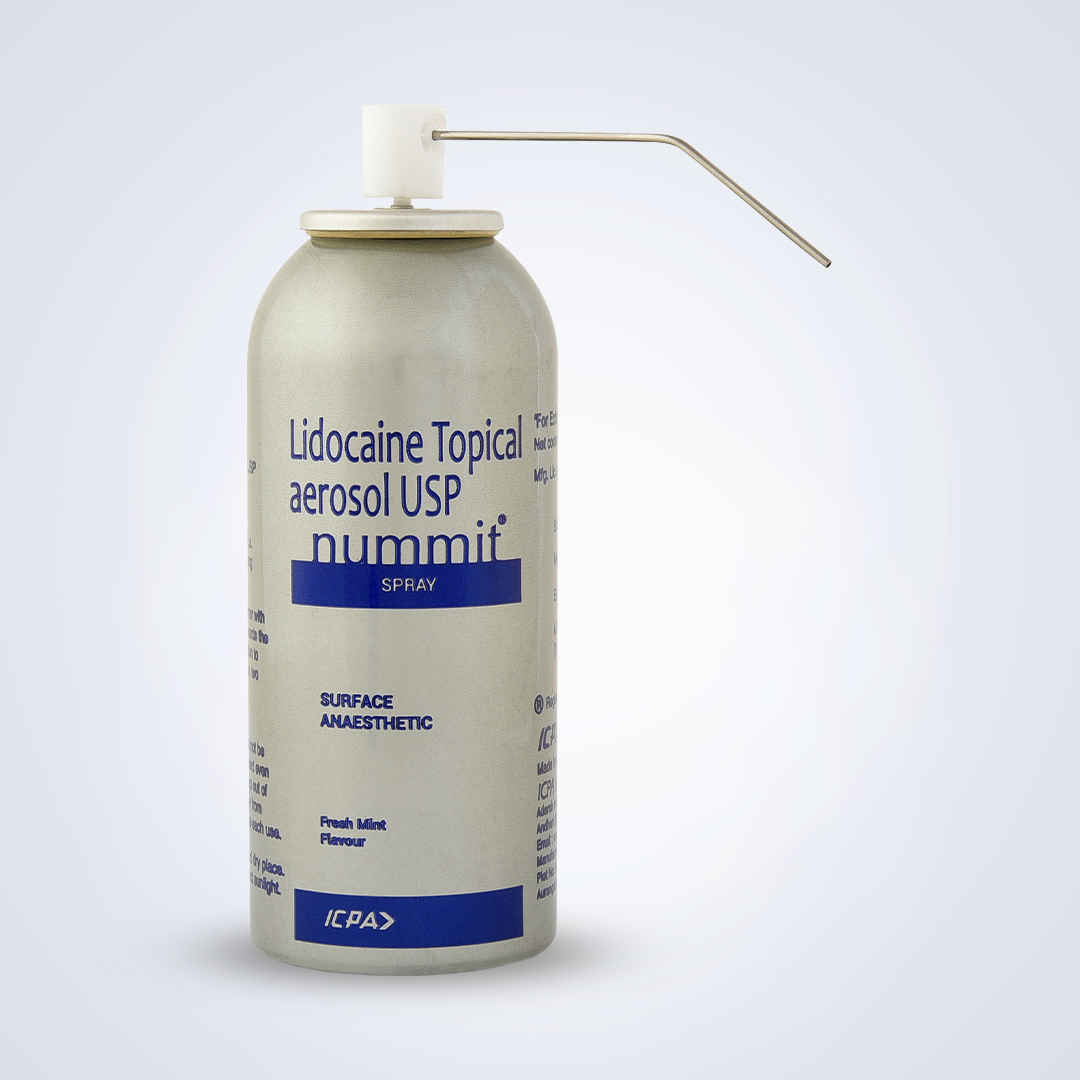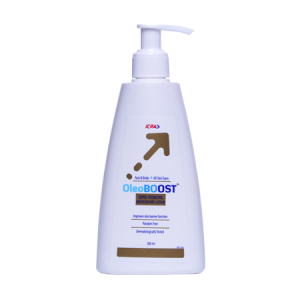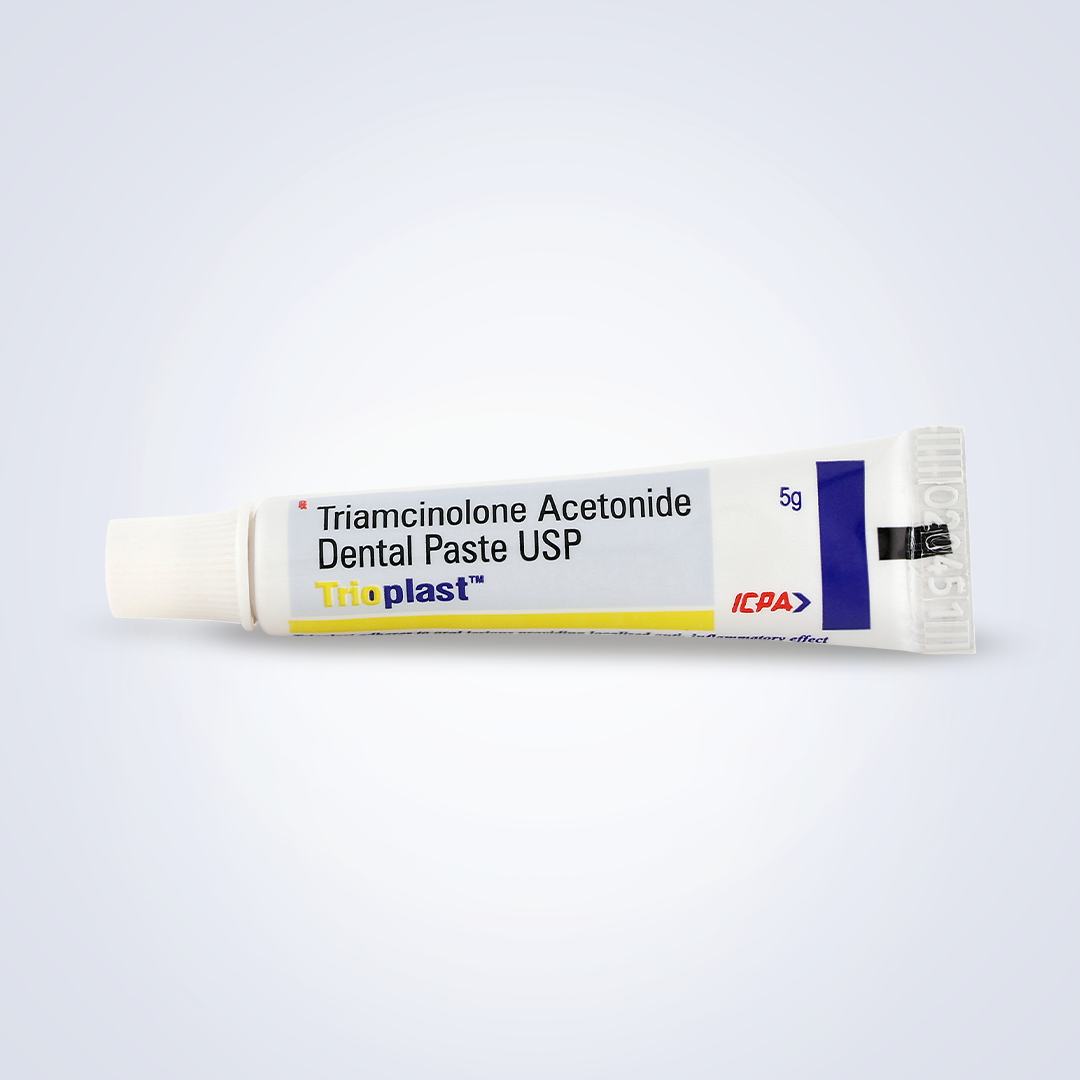Derma
Derma
Showing all 8 results
-
Moyzen Cream 100gm
Read More Quick ViewMoisturising Cream
Softens and Rehydrates dry skin
Composition:
Light Liquid Paraffin 6% w/w White Soft Paraffin 15% w/w Cream base q.s. Preservative q.s. (Formulation available – I.P. – Domestic, B. P. – Export)Mode of action:
Stratum corneum is the surface layer of the epidermis. Water content of Stratum corneum (10%) is controlling factor in maintaining skin flexibility. When water content falls below 10%, Stratum corneum becomes less flexible and rough. This phenomenon is termed as ‘dry skin’. Certain skin disorders and systemic diseases also produce dry skin.
Moyzen produces thin occlusive film on the Stratum corneum, which prevents loss of moisture from skin surface.Indications:
Dry skin conditions.Directions for use:
Apply to the affected area and rub well. Use as often as required. Recommended units for application – Face and neck 2.5 fingertip units, Arm (shoulder-wrist) – 3 fingertip units, Hand -1 fingertip unit, Leg- 6 fingertip units, Foot – 2 fingertip units.Precautions:
Do not rub skin with towel after Moyzen application.Presentation:
Lamitube of 100g (3.53 oz) -
Moyzen Liquid 100ml
Read More Quick ViewSoftens and Rehydrates Dry Skin
Composition:
Light Liquid Paraffin 63.4% w/w Base q.s. (Formulation available – I.P. Domestic, B.P. – Export)Mode of action:
Stratum corneum is the surface layer of the epidermis. Water content of Stratum corneum (10%) is controlling factor in maintaining skin flexibility. When water content falls below 10%, Stratum corneum becomes less flexible and rough. This phenomenon is termed as ‘dry skin’. Certain skin disorders and systemic diseases also produce dry skin.
Moyzen produces thin occlusive film on the Stratum corneum, which prevents loss of moisture from skin surface.Indications:
For the relief of dry skin associated with Contact dermatitis, Atopic dermatitis, Senile Pruritus, Ichthyosis and related dry skin conditions.Directions for use:
Apply Moyzen on wet skin, preferably after bathing and thereafter pat skin dry.Precautions:
Do not rub skin with towel after Moyzen application.Presentation:
HDPE bottle of 100ml (3.38 fl.oz.) -
Moyzen Plus
Read More Quick ViewTreatment Bar. Softens and Rehydrates Dry Skin.
Composition:
Olive Oil:
• Penetrates deep into the skin providing long lasting moisture.
Glycerin:
• A natural moisturizer draws water and prevents dryness of skin.
Fortified with Aloe Vera and Vitamin E:
• Maintains skin elasticity and suppleness.Keeps skin pores free from dirt and keeps skin soft and tender.Indications:
Dry skin conditions.Directions for use:
Ensure a rich lather using a little hot water and clean the affected area. Do not rinse excessively. Pat skin dry. Can be used in hard water also.Caution:
Avoid contact with eyes. Flush eyes with water in case of accidental entry of lather. If there is irritation of the skin, discontinue use and consult your doctor. Keep out of reach of children.Presentation:
Bathing Bar of 100g (3.53 oz). -
Mucofibro Antioxidants
Read More Quick ViewComposition:
Mucofibro is a formulation of antioxidants available in the form of softgel capsules.
Each soft gelatin capsule contains
Lycopene – 5 mg,
Beta-carotene – 10 mg,
Alpha lipoic acid 50 mg,
Elemental copper – 1 mg,
Elemental selenium – 75 mcg,
Vitamin E – 10 IU and
Zinc sulphate – 27.45 mg.Reactive Oxygen Species (ROS) —Free radicals
ROS are chemical molecules, specifically oxygen species formed by the partial reduction of oxygen that are generated during mitochondrial oxidative metabolism as well as in cellular response to cytokines and bacterial invasion.
The double-edged sword
ROS serve as crucial players in our body’s defense against invading pathogens. ROS play pivotal roles in cell signaling, gene regulation, and antimicrobial defense. These molecules have antimicrobial properties that help combat infections in the oral cavity. However, ROS can be a “double-edged sword” since an excessive presence of these molecules can become cytotoxic to our cells.
The concept of Oxidative Stress:
To counteract the deleterious effects of excessive free radicals, our bodies possess an antioxidant defense system that can inhibit and reduce the damage caused by the harmful ROS. However, when ROS levels exceed cellular antioxidant capacity, a condition termed oxidative stress occurs. Oxidative stress is implicated in the pathogenesis of several conditions including aging, diabetes mellitus, hypertension, and cancer.
Antioxidants:
These are oxidative stress busters used as auxiliary treatments in a variety of conditions such as cardiovascular diseases, pulmonary diseases, aging, and atherosclerosis.
Mucofibro: Antioxidant supplemements
With an optimal combination of anti-oxidants, carotenoids, and minerals, Mucofibro detoxifies the cells by scavenging the cell-damaging free radicals. This cell detoxification removes oxidative stress in the cells and enhances the overall tissue healing capacity, which results in faster healing of various oral lesions and conditions. It also improves the clinical outcomes of various non-surgical and surgical treatments.
Indications
1. Precancerous lesions: Leukoplakia, Erythroplakia (to prevent/ slow down the malignant transformation)
2. Precancerous conditions: Oral Submucous Fibrosis (to prevent/ slow down the malignant transformation)
3. As an adjunct to non-surgical & surgical periodontal treatments for various gum diseases: Gingivitis and Periodontitis
4. As an adjunct to implant treatments to improve osseointegration.
5. As an adjunct to bone regeneration & tissue engineering procedures.
6. In various oral surgical procedures for improved healing.
7. For improved healing of oral ulcersA. The role of antioxidants in periodontal health
The link between oxidative stress and periodontal disease
Periodontal disease is a persistent inflammatory condition that impacts the periodontal tissues. Emerging research has elucidated the connection between oxidative stress and periodontal disease. An article in a high-impact factor journal terms periodontitis as an inflammatory disease of oxidative stress.
In the early stages of periodontal disease, especially in the case of periodontitis, a prominent oxidative process unfolds, characterized by elevated levels of reactive oxygen and nitrogen species (ROS and RNS). Evidence says that much of the damage done to periodontal tissues and supporting bone structure is due to ROS emission.Promising results
Recent evidence supports the idea that antioxidants can play a pivotal role in the treatment of periodontitis. A meta-analysis comprising fifteen clinical trials demonstrated uniformly positive outcomes associated with antioxidant supplementation during periodontitis treatment. Lycopene is emerging as a promising treatment modality as an adjunct to full-mouth periodontal treatment.
These findings offer hope and promise for those seeking alternative therapies to complement traditional periodontal treatments.B. The role of antioxidants in implantology
1. Antioxidants like lycopene exert proliferative effects on human osteoblasts.
2. Antioxidants like lycopene may increase new bone formation in periodontal and dental implant treatments.
3. Lycopene improves implant osseointegration and prevents delayed osseointegration.
4. Antioxidants also help in bone formation and prevent bone loss under osteopenic conditions.C. Antioxidants in pre-cancerous conditions like Oral Submucous Fibrosis (OSMF)
Mucofibro improves mouth opening and prevents the malignant transformation of OSMF (and other precancerous lesions/ conditions).
1. Lycopene, a carotenoid derived from plants, demonstrates anti-carcinogenic properties and prevents the malignant transformation of precancerous lesions and conditions. Lycopene exhibits the highest physical quenching rate constant with singlet oxygen. Lycopene is the first line of treatment for OSMF, apart from demonstrating profound benefits with precancerous lesions such as leukoplakia.
2. β-carotene, a precursor of vitamin A, is an antioxidant that traps free radicals. It retards the development of cancer cells by minimizing the free radical-induced damage.
3. α-Lipoic Acid (LA) is known as a universal antioxidant as it can remove free radicals in water as well as lipid medium.
4. α-Tocopherol (Vitamin E) has the antioxidant action.
5. Selenium (Se) is an anticarcinogenic agent that prevents unwanted cell growth.
6. Zinc (Zn), essential for multiple cellular functions, acts as an antioxidant andstabilizes membranes.
7. Copper (Cu) enhances the activity of antioxidants.Dose
2 times a day for 30 days or as directed by the doctor
Presentation
2 x 10 softgels
-
Mucopain 15gm
Read More Quick ViewComposition:
Benzocaine I.P. 20% w/w in a water-miscible base Topical anaesthetics come in various dosage forms, such as gels, sprays, creams, ointments, patches to provide the clinicians with precise options for application under various situations.
Understanding Benzocaine:
Benzocaine is an ester type molecule used for topical (surface) anaesthesia in a variety of settings, including dental procedures, preparation for infiltration anesthesia, and pain relief minor traumas to oral mucosa.
Topical anaesthetic agents such as Benzocaine penetrate the oral mucosa effectively and offer local anaesthetic activity that lasts for 10-20 minutes. The poor water solubility of Mucopain makes it safe for topical use. Local anaesthetics reversibly block nerve transmission, when applied to a limited area of the body. They bind to the sodium channels in the nerve membrane and prevent the entry of sodium ions in response to the membrane’s depolarization.
Mechanism of action:
1. Benzocaine acts by reversibly binding to and inhibiting sodium channels in the neuronal cell membrane.
2. Benzocaine first enters the cell in a nonionized form and then becomes ionized after traveling through the membrane bilayer.
3. Once ionized, benzocaine starts inhibiting the voltage-gated sodium channels by binding to their alpha subunit.
4. This binding stops cellular depolarization and minimizes the chances of action potential generation.
5. Benzocaine can bind more easily to sodium channels when they are in an open configuration.
6. The pKa value of local anesthetics is critical as it helps to determine their onset of action. Since benzocaine’s pKa value is relatively low (2.6) in comparison to other local anesthetics, its onset of action is quick, its rate of action is fast and relatively pH-independent.Indications:
For topical anaesthesia of all accessible mucous membrane, except eyes. For temporary local relief of pain associated with dental conditions and oropharyngeal disorders.
1. Nutritional deficiency induced ulcers
2. Traumatic ulcers, such as lip bite, cheek bite
3. Treatment induced ulcers: due to orthodontic appliances, oral surgical appliances, dentures
4. Mucosal injuries during instrumentation in dental procedures
5. Ulcers from autoimmune disorders, such as lichen planus, pemphigoid, pemphigus.
6. Oral submucous fibrosis (OSMF)
7. Oral ulcers in cancer patientsDirections for use:
For oral mucosal use only, as directed by a dentist. For the temporary relief of pain due to ulcers, or injuries from minor dental procedures.
Warning:
Discontinue medication and consult a doctor if sensitivity or irritation occurs. Safe use of Mucopain is not established during pregnancy on the foetus. Do not cover the affected area with cotton or other material. Not for infant use.
Methemoglobinemia warning
Use of this product may cause methemoglobinemia, a serious condition that warrants prompt clinical management because it reduces the amount of oxygen carried in the blood. This can occur even if one has used this product before. Stop use and seek immediate medical attention if you or a user in your care develops any of the following:
- pale, gray, or blue-colored skin (cyanosis)
- headache
- rapid heart rate
- shortness of breath
- dizziness or lightheadedness
- fatigue or lack of energy
Presentation:
Lamitube of 15g (0.52 oz)
-
Nummit Spray
Read More Quick ViewComposition:
Lidocaine U.S.P. 15% w/w Inert solvents & Propellant q.s. to 100% w/w Each actuation delivers 7.5mg of Lidocaine USP, CFC free.
Mode of action:
Local anesthetics like Lidocaine reversibly block nerve transmission, when applied to a limited area of the body. They bind to the sodium channels in the nerve membrane and prevent the entry of sodium ions in response to the membrane’s depolarization.
Indications:
Preoperative surface anesthesia and for painful oral conditions.
Directions for use:
Hold the container with the extension tube pointing towards the area of applications. Press the button to spray. Allow 2 seconds between two subsequent sprays. Shake the container before each use.
Caution:
Flammable, Pressurised container. Must not be punctured, broken, or incinerated, even when apparently empty. Keep out of reach of children. Keep away from eyes.
Storage:
Store in a cool and dry place. Keep away from heat and direct sunlight.
Presentation:
Metallic canister of 100 gm (3.52 oz)
-
Oleoboost Lotion 200ml
Read More Quick ViewOleoBoost (Super Hydrating Moisturising Lotion):
A unique combination of 24 ingredients, OleoBoost not only hydrates the skin but also forms a protective layer on the surface to prevent moisture loss. A special blend of shea, cocoa, aloe and mango butter. OleoBoost offers anti-inflammatory, regenerative, and wound healing property which revitalizes dry, irritated and lacklustre skin. The lotion contains citric acid and vitamin E which gently exfoliate with anti-oxidant action to help prevent premature aging of the skin. The lotion also contains Zinc Oxide that reduces itching and lightens the skin. Dimethicone forms a protective layer on the surface to prevent moisture loss and helps the skin breathe.
-
Trioplast 5gm
Read More Quick ViewComposition:
Triamcinolone acetonide IPNSP 0.1%w/w, Oral paste – QS.
Preservatives: Methyl paraben IP/USP0.2%wlw, Propyl paraben IP/USP0.02%w/w. Triamcinolone Acetonide is a synthetic glucocorticoid with anti-inflammatory and immunosuppressive properties.Components that improve the action of Triamcinolone:
Retention: Carboxy Methyl Cellulose: Moisture retention for faster healing
Protection: Pectin: Gelling agent with protective coating
Release: Gelatin facilitates controlled release of steroid
Clinical conditions:
Recurrent Aphthous Stomatitis (RAS)
Recurrent aphthous stomatitis (RAS), commonly known as “canker sores”, is a form of benign inflammation of the oral mucosa. Although the term “canker sores” is commonly used to describe any abnormality of the mouth, the term, strictly refers to painful oral ulcers that come and go over time.
Recurrent aphthous stomatitis affects 1 in 5 persons and usually begins in adolescence and teenage years. During an episode, it may present with 1-5 painful ulcers that last for 1 – 2 weeks. These ulcers are typically seen on the inner cheeks, inner lips, underside of the tongue, or soft palate. Just before the appearance of an ulcer, one may feel a burning sensation or a lump in the area. Ulcers may be considered minor if they are less than 1⁄2 inch and heal in less than two weeks without scarring. They are called major if they are greater than 1⁄2 inch, take longer than two weeks to heal and leave scars. Some patients may have multiple recurrent crops of small, pinpoint, painful ulcers known as herpetiform RAS (these ulcers are not related to herpes virus infection). Patients are considered to have severe RAS when they have continuous ulcers with few, if any, ulcer-free periods, regardless of the size and/ or number of lesions.
Desquamative Gingivitis
The term “desquamative” comes from the Latin word “desquamare,” meaning to scrape fish scales. Desquamation refers to the shedding of epithelium, leading to skin or mucous membrane exfoliation. Desquamative gingivitis (DG) is a clinical description of gingiva marked by severe redness, peeling, vesicles, or bullae that can result in ulcers. It affects both the free and attached gingival mucosa. DG represents a clinical manifestation of various diseases.
The most common culprits include dermatological conditions like lichen planus (LP) in 70-75% of cases, cicatricial pemphigoid (CP) in 9-14% of cases, and pemphigus vulgaris (PV) in 4-13% of cases.
Oral Submucous Fibrosis
Oral submucous fibrosis (OSMF) is a precancerous condition with chances of malignant transformation in 1.5–15% of the cases. OSMF is mainly caused by chewing betel nut, which is accelerated by addition of tobacco. Other risk factors include genetic predisposition, autoimmunity, nutritional deficiencies, human papilloma virus (HPV) infection, consumption of spicy foods, and more.
OSMF is characterized by chronic inflammation, excessive collagen deposition in the submucosal (the connective tissue below the oral mucosal epithelium) layers, local inflammation in the deep connective tissues, and degenerative changes in the muscles. OSMF patients complain of severe burning sensation in the mouth while eating spicy foods. They also experience xerostomia (dry mouth), restricted mouth opening, restricted tongue mobility, dysphagia, and many other symptoms.
Indications:
TRIOPLAST is indicated for:
- Inflammatory disorders of the mouth
- Painful ulcers, lesions of oral mucosa
- Recurrent and resistant aphthous ulcers
- Desquamative gingivitis, mucositis, and stomatitis
- Ulcerative conditions associated with Oral lichen planus, pemphigus, and pemphigoid Oral submucous fibrosis
- Non-healing ulcers of the oral mucosa, in cancer and non-cancer conditions
- Contact cheilitis
- Hemangioma
- Erythema multiforme
Contraindications:
This preparation is contraindicated in patients with a history of hypersensitivity to any of its components . Because it contains a corticosteroid, the preparation is contraindicated in the presence of fungal, viral or bacterial infections of the mouth or throat.
Directions for use:
Squeeze out about a 1/4th of an inch long ribbon of TRIOPLAST on the tip of a clean & dry finger. Apply with little pressure to the lesion until a thin film develops. Hold in position until it become sticky. The preparation should be applied at bedtime to permit steroid contact with the lesion throughout the night. Depending on the severity of symptoms, it may be necessary to apply the preparation two to four times a day, preferably after meals. Do not eat or drink for half an hour after applying TRIOPLAST.
Storage:
Store below 30’C.
Presentation:
Trioplast 0.1% oral paste is supplied in 5gm laminated tube containing 1mg of triamcinolone acetonide per gram of paste.
Quick Links
Our Products
Information
Contact us
- 216-219, Adarsh Industrial Estate, Sahar Road, Chakala, Andheri (East), Mumbai - 400099
- Fax : 28216928
- +91 22 40065305 / 40065306 / 40065307
- info@icpahealth.com


Selected Icpa Products
Click on Add to cart to add this item in cart.
| PRODUCTS | QTY | PRICE | VALUE in INR |
|---|
Selected Icpa Products
Click on Add to cart to add this item in cart.
| PRODUCTS | QTY | PRICE | VALUE in INR |
|---|

